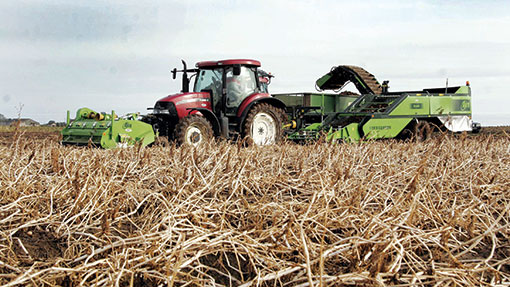Soil health key to breaking potato yield plateau

Potato yield increases have stuttered to a halt in a similar manner to cereals in recent years and experts believe improving the state of British potato-growing soils will be vital to drive yields higher again. Adam Clarke reports.
Boosting soil nutrition and cutting compaction will be two key factors in breaking through the yield barrier that potato growers have hit over the past 20 years.
Maincrop potato yields increased sharply up to the mid-1990s, but since then yields have stagnated at about 44.6t/ha, according to Potato Council data covering 1960-2013.
Speaking at the recent Cambridge University Potato Growers Research Association (CUPGRA) annual conference, Marc Allison, potato nutrition expert at NIAB-CUF, said there was evidence that this plateau was being caused by a lack of soil fertility, and that many potato growers would say the soils across their farms were not as fertile as they were a generation ago.
“There clearly could be many factors influencing the yield trend, but soil fertility needs to be understood and addressed, or we won’t see a return to an upward curve,” he said.
Dr Allison highlighted the need for a model to define soil fertility, which was a major factor in influencing the value or rent value of potato-growing land.
He said that it was very difficult to predict where the highest yield would come from when comparing a number of fields with a range of soil types and nutritional properties.
Historically, fertility has been judged on chemical properties such as organic matter levels and availability of the major nutrients of nitrogen, phosphate, potash and magnesium.
“I believe we need to think about the physical (compaction), biological (pests and diseases) and chemical properties all interacting together to get the soil working in our favour,” Dr Allison told the conference.
The impact of compaction is one area that was limiting fertility and Dr Allison added that the water content of the soil at the time of cultivation could have a dramatic effect on yield.
Blair McKenzie, physical soil scientist at the James Hutton Institute, agreed the loss of soil porosity was hindering yields.
The losses of macro pores are the most critical for plant growth, and these include cracks, old root channels and earthworm burrows, as they allow the movement of water and air, which was important for the uptake of nutrients and allow roots to reach the subsoil, he said.
“It was thought that vertical macro pores could be resistant to compaction from wheeled traffic to an extent, but we have carried out tests that show otherwise,” he added.
“There is a horizontal, or shear, movement as a machine passes over the ground that can completely destroy any macro pores right down the soil profile,” explained Dr McKenzie.
He also noted that the trend towards larger and heavier machinery to carry out fieldwork was also creating subsoil compaction – the soil zone below the cultivated area.
The heavier the machine, the deeper the damage to soil structure will be, even with low ground-pressure systems, he said.
“There may be less visual damage to the topsoil, but you are just moving the problem to where it is much more difficult and expensive to correct, because the axle load is much higher,” added Dr McKenzie.
The intensity and frequency of passes used in root crops such as potatoes is also a concern, with high-axle-load machinery going over a field four to eight times in a season.
“We need much more information on how we are damaging our soils. Technology such as GPS will also help us target where that damage is going in controlled traffic systems,” he explained.
Soil organic matter may also be able to help soil “resist” compaction, but it’s not as straightforward as adding manures to soils.
“Yield increases from applying organic matter are modest at best in the short term and we need to understand what the impact could be in the longer term,” said Dr Allison.
“It’s taken soils a long time to lose organic carbon levels and may take much longer to build back up again, but it needs to be done in the correct manner,” he added.
(More on lifting potato yields )

